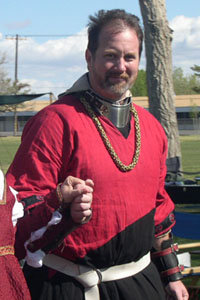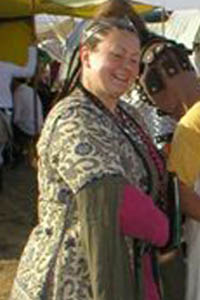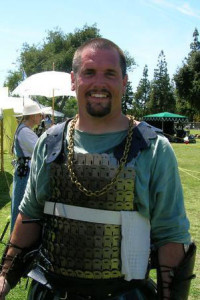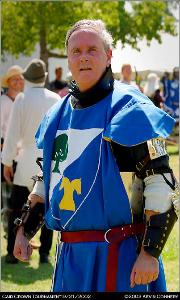SCA-Beathog went to war. At the request of her king, Edric V, she followed His armies onto the lands of the Kingdom of Atenveldt, where Caid would lend support to Her allies there, both in and out of combat. A non-fighter, SCA-Beathog, and others of her household, support both Crown and Kingdom by entertaining the masses with both story and song (a kind of SCA USO Show, if you will), and often play the role as bard, carrying news throughout the Known World.
———-
That’s my SCA story, so far, at least. But, how might my Beathog persona fit into this scenario, I wonder? How might she be comfortable taking such a trip?
I spent a lot of time packing my car and trailer, during the days before the war, as I always do. I began to wonder just how much of the stuff I take with me, each and every war, would be a comfort to Beathog on such a journey, and how much of the stuff would be strange to her or would be, jarringly, of another age. I had originally planned to take photos of the different areas of my camp, to examine the details, later. The inclement weather made this exercise difficult, but the harsh weather, in itself, offered quite another very interesting perspective for me. The endless rain, the subsequent muddy roads, and the bitter cold were certainly a common occurance in 14th century Scotland. I think, in the area of persona studies, this would be called the immersion method of study. 🙂
I did manage to make several observations, which I find somewhat helpful. I list the following items to be those that help me to feel like Beathog, for whatever reason. Hey, if I can feel like Beathog, I can become her.
1. my spurtle – it’s a stick that’s intended for stirring oats, brought from Scotland, and always kept, near at hand, in my camp kitchen
2. my 14th century drop spindle & several varieties of Yorkshire wool, purchased there
3. a sheepskin brought, by my parents, from Scotland – the ONLY thing I found to be efffective in keeping my seat warm!
4. my hood & liripipe, in Donnachie red wool – I hardly feel like Beathog at all, without this item!
5. rain, bitter cold & MUD – This was annoying, but manageable, with leather shoes, woolen socks (my shoes were muddy, certainly, but my feet were always warm and dry} and hat (yes, even while sleeping!), layers of clothing in linen and wool. It really is a great thrill to find out your garb is much, much more than a costume!
6. chamber pot – yes, yes, yes!!
7. period menus – For the most part, we do an excellent job in eating foods available in the SCA period and, when I am cooking, I rarely use foods that were not available in the 14th century. I think the most important part of this, for me, is that the foods I eat at war are different than the foods I eat at home. I eat sausage at home, but the sausages Domhnall makes for war have period seasoning and thus a different taste than the varieties we eat at home. I use so much oats and leeks, as well, that I get the attention of the grocery clerks when we shop for war.
8. camp furnishings – While not a requirement in our camp, we do have many period pavilions. My personal pavilion may not be a 14th century style, but it is quite comfortable and I accept it, gratefully, over a modern tent alternative. We have replaced (most) of our plastic tables with wooden ones (using one plastic table, still, for dishwashing) and we are on our way to having (only) wooden benches for dining. We are (currently) working on replacing all of our chairs with wooden ones. I love, love my new chair, and do not care that it is more appropriate for SCA-Beathog than my 14th century persona. It is NOT my former, 10-year old director’s chair. Yay!
———-
Getting rid of ALL of our modern chairs is our priority, certainly, as they would be quite jarring to Beathog (some of them are quite jarring to everyone, SCA or not). While we do work very hard (at my insistence, I admit) at enjoying a period menu, I think Beathog would certainly be confused by much of the other items, found in our camp, at any given war. I have been trying to encourage everyone to use a critical eye and to keep the much-necessary plastic containers out of site. We seem to be getting quite lazy about our serving dishes, for example, and serving out of plastic storage containers and bags, rather than using all of those beautiful dishes we carry around with us.
We are doing so much better at occupying ourselves with period activities, and limiting conversations about modern subjects, such as television, and the like, but many of us still have a long way to go in this area.
An SCA friend of mine has a brilliant insight about this, I think. She says some people never leave the realm of Modern Life – they have been raised in that world and do not feel comfortable leaving it. I think she’s absolutely correct, and that’s why I’m trying to encourage all of my household to get to know their personas, and to feel comfortable about walking in those shoes for awhile……… Yes, even in the mud!
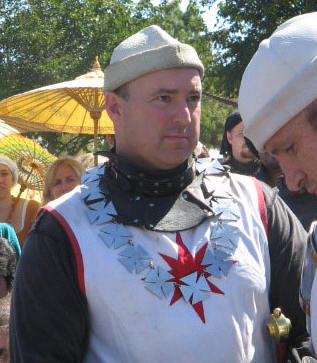 I chose a Terza Rima for Sir Dante, invented by the 13th century Italian poet of the same name for his epic poem, The Divine Comedy.
I chose a Terza Rima for Sir Dante, invented by the 13th century Italian poet of the same name for his epic poem, The Divine Comedy.
